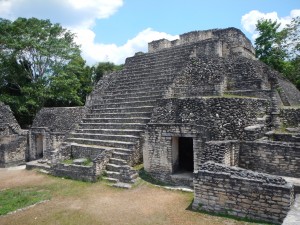I could observe Atta cephalotes (Leaf-cutter Ants) in the morning. They had orange-brown body, long limbs, and butt-shaped head with horns. There were less of them working than last night, I am guessing that A. cephalotes might be nocturnal. This is supported by the fact that at Caracol Archaeological site, I could only see recent work trail of A. cephalotes without the laborers themselves. Also I could find them in their mound but not working outside. Unlike other ants I have observed until now, I could distinguish between the minor and major workers.
In the morning I could also find an ant from genus Pachycondyla which the locals call “tiger ants.” They say its well developed sting is 10 times stronger than that of fire ants. They were at least 15mm up to 20mm, shiny dark-gold body with hair, with very strong-looking mandibles. Scott says Pachycondyla ants are not polymorphic.
Other than Atta and Pachycondyla, I found two more kinds of ants which I could not identify at the moment, including the one described in the last blog post. The other species was black overall, short and fat overall body, hairy abdomen.
After breakfast, we headed for Caracol Archaeological Site. Named because of the frequent excavation of shells (which in Spanish is caracol), is a major Mayan city state which once had the power enough to defeat well-known city of Tikal. The city is designed so that suburbs, than peasant district will spread radially from the rulers’ center. The center comprised of humongous temples, apparently still the highest structure in Belize. A population matching half of that of today’s Belize occupied Caracol. It is amazing that such megalopolis was supported in such remote and highly vegetated area. What is more, I am amazed by how such vast ecosystem could recover from long disturbance by the Mayan cities in just 1000 years.
The guide explained that Mayan cities disintegrated gradually as people abandoned them. If human civilization expand, extract, and exploit unsustainably, similar fate of chaos and disintegration seems obvious. Unlike, however, the Mayans, we will have no where to go after abandonment because our planetary influence have extracted everywhere on Earth so dry.



